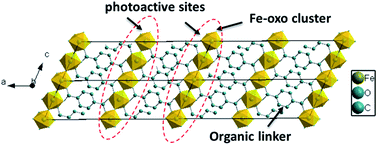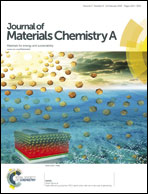Solvothermal synthesis of MIL–53(Fe) hybrid magnetic composites for photoelectrochemical water oxidation and organic pollutant photodegradation under visible light†
Abstract
Metal–organic frameworks (MOFs), a new class of porous crystalline materials, have attracted great interest as fascinating materials for sustainable energy and environmental remediation. However, the functionalization and diversification of MOFs are still challenging and imperative for the development of highly active MOF-based materials. Here, we present our recent finding on the design of a multifunctional MOF-based heterostructure composed of one-dimensional MIL–53(Fe) microrods with the magnetic nanospheres decoration (MHMCs), which can be easily fabricated by a one-pot solvothermal process. The MHMCs as a photoanode reveal a remarkable, steady and reproducible photocurrent response and exhibit effective photoelectrochemical performance toward water oxidation under visible light. Moreover, the MHMCs show high efficiency in a H2O2-mediated visible light photocatalysis process. The MHMCs/H2O2 system exhibits enhanced apparent rate constants for the degradation of Rhodamine B (RhB) and p-nitrophenol (PNP), which are significantly higher than those of Fe2O3 and Fe3O4 photocatalysts, respectively, under visible light irradiation. This study provides new physical insights into the rational design of advanced MOF-based materials for energy and environmental applications.


 Please wait while we load your content...
Please wait while we load your content...